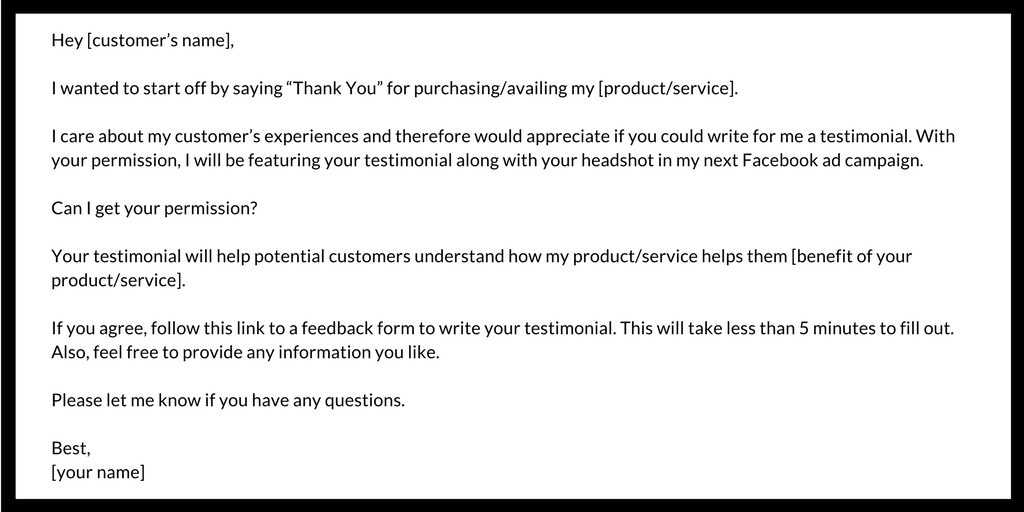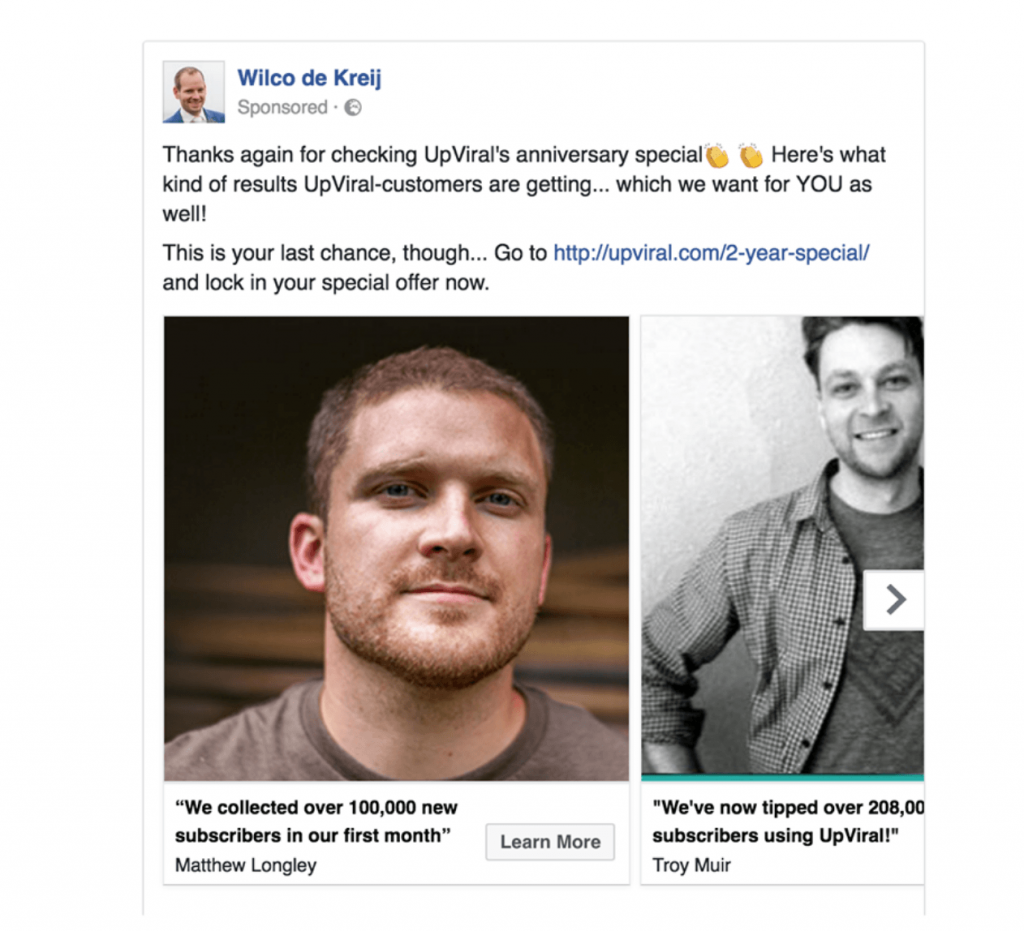You decide to advertise on Facebook because you want to increase sales. Way more powerful than organic posts, Facebook Ads let you target the exact audience based on their age, location, and interests. However, running Facebook ads without a plan doesn’t guarantee results.
Let me start off by saying that there are many types of Facebook ads. There’s the regular link click ad, video ad, canvas ad, page like ad, and many others. Your choice of ads depends on your business goals. But here’s the thing: You can leverage each of these ads but still don’t get the results you want.
Non-converting Facebook ads lack one powerful element: Social proof.
What Is Social Proof and Why Do Your Facebook Ads Need It?
In 1984, Dr. Robert Cialdini wrote a book entitled “Influence: The Psychology of Persuasion.” He outlines the 6 Principles of Persuasion, and one of them is social proof.
Social proof happens when a person acts based on what most people are doing. We’re willing to give something a try if others recommend it. If you’re like most individuals, you would seek the opinions of your peers regarding a product before you make a purchase.
Picture this scenario:
You’re someone who never considers the idea of wearing cropped jeans. But because your friends and favorite celebrities are doing it, you jump on the bandwagon.
As a business owner, social proof can make or break your advertising efforts. Social proof can be used as a powerful tool to amp up your sales. You can use it to heavily influence people’s perception of your business.
My best converting Facebook ad
I fully realized the true potential of social proof as I tested multiple Facebook retargeting ads. Of all the ads I ran, I found this ad to bring in the most conversions. It was the only ad that incorporated social proof:
As you can see from my best performing ad, I used customer testimonials as a form of positive social proof. If people were to believe my product works, there had to be an effective way to show them the benefits of using it without being “salesy.”
This ad is evidence that social proof in the form of testimonials gets people to conform. Testimonials make the benefits of choosing your product more tangible because they are written in their voice – not yours.
Many business owners running Facebook ads regret not using social proof sooner. Who wouldn’t want social proof when it adds credibility to your business?
How to Get Testimonials (Making it easy)
Now we move on to the next step – asking for testimonials. Having worked with clients over the years, I realized that asking for testimonials was something they struggled with.
It gives them the heebie-jeebies, as it did to me when I was new in business. But you have no choice but to get past this dilemma if you want to make your ads work.
Luckily, I compiled a list of tips that will put you on the right track.
Important note: Various countries have a different set of laws in online testimonials. While the tips in this post help you, be sure to seek legal counsel.
1. Send a testimonial request email.
Since you want a testimonial, all you need to do is ask. Remember that if you don’t ask, you don’t get.
The best way to go about generating testimonials is to email your customers about it. Keep your message warm, professional, and personalized. Let your audience’s persona guide you through the writing process.
Consider the email subject lines below.
- So… What do you think?
- How was your service at [business name]?
- Are you enjoying the [product/service]?
Here’s an email template you can use:

In your message, you can provide a link to a separate feedback form (Google doc) or list out your questions. After you send out all those testimonial request emails, do a follow-up.
2. Ask the right questions.
Testimonials that are sure to garner a positive response are those that dig deeper. They highlight your unique selling point. They address common barriers and hesitations.
You can make your testimonials go in the direction you want.
What’s the trick? Ask your customers all the right questions in your testimonial request email.
Below is a list of questions I’ve used myself and borrowed from Copyblogger:
- What did your situation look like before you used it?
- How would you explain my product/service to a friend?
- Have you tried other solutions before you came across mine? How did those work out?
- What is the best thing about my product/service?
- Would you recommend my product/service? If yes, why?
- Can you describe it in 3 words?
- Can you share your biggest objection while purchasing it?
- Were you able to save money by using my product/service? If yes, how much?
- Is there anything else you would like to add?
- What have we done for you that others haven’t?
3. Create a testimonial contest.
Oftentimes, you’ll need to nudge even the best customers into writing a testimonial. It’s not something that occurs to a lot of people.
There are two possibilities that explain why happy customers don’t always write testimonials. One, they’re preoccupied with other kinds of stuff. Two, you haven’t established a personal relationship with them yet.
Why not entice them with an incentive? Incentives can serve as a powerful motivator.
In this case, consider launching a testimonial contest. I have to tell you – running a contest to generate testimonials may have an inauthentic vibe. Why? There’ll be a lot of contest entrants who don’t belong to your current customer base.
Even so, a contest is still worth a shot because of the speed at which it generates results.

In a testimonial contest, you design a landing page that includes the following:
- Contest information. Whether it’s the headline or bullet point summary, it should show all the details about your contest.
- Feature a reward. A reward should entice your audience and relate to your business. This positions you at the top of your customers’ minds and promotes brand loyalty.
- Testimonial submission form. Incorporate a form on your landing page where people can submit their testimonials. Include a list of questions you want them to answer.
- Unique share link. Participants must share your contest with their friends using a unique referral link. Each share brings in new participants.
- Rules and guidelines. To prevent confusion, specify the mechanics of your contest, do’s and don’ts, and how you’re going to pick winners.
If you’re looking for a tool that creates testimonial landing pages, use UpViral. It incorporates a unique referral link that encourages unlimited sharing. That way, your testimonial contest keeps on getting results for as long as you run the campaign.
4. Reach out at the right time.
You’re disappointed. You spent so much time and effort in creating the perfect testimonial request email. Still, only a few of your recipients respond.
Sometimes, your timing makes all the difference.
When’s the best time to send that testimonial request email? The answer: When your customers start to experience the benefits of your product. This can be within the week they made a purchase.
It is during these times that your customers are in the best mood to say something great about you. Don’t wait for weeks or months before you send out an email. Delays result in no response or a weak response.
Customers have a lot to say when you ask their opinions early in the process.
5. Optimize for mobile.
Most people nowadays use mobile phones to access the internet. This makes mobile optimization a must when soliciting testimonials. If you link to a separate page from your testimonial request email, see to it that the page adapts to their device.
Here are tips to create a mobile-optimized page:
- More white space. Fight the urge to add as many elements as possible on your page. White space keeps your page simple and professional. It creates a positive user experience.
- Legible and large text. You wouldn’t want people leaving your page because they had a hard time reading your text. Stay away from small and fancy fonts because they interfere with your message.
- Few form fields. Don’t ask mobile users to fill out many form fields. Fewer form fields ease the process of writing a testimonial.

I Don’t Have Customers Yet… What Should I Do?
You’re new to business and decide to use Facebook ads. The problem is, you don’t have customers who will write testimonials for you.
Use whatever you have at your disposal. These can be things like:
- Blog and social media comments left by visitors
- Feedback from your colleagues, family members, and friends
- Positive email messages
If you use any of the options above, be sure to send a testimonial request email to the people responsible for those feedback. Ask their permission to allow you to use their words as your testimonials.
You’ll be surprised that a lot of them will say YES. Some may even volunteer to make better their words or allow you to tweak and send it to them for their approval.
3 Best Practices When Creating Your Facebook Ad
Congratulations. You already know the ways to generate customer testimonials for your FB ads. Before you start your FB ad campaign, there are a few things you should keep in mind.
In this section, I’m going to share with you three things I have learned from my best performing ad. Ready?
1. Target your testimonial ads to warm or hot leads.
Resist the temptation to target your ads to a broad audience. Testimonial ads are best served to warm or hot leads. In a recent video, I discussed the 3-step inside-out method that explains how easier it is to start with the audience that already knows you.
Targeting people who’ve already had some interaction with you gets better results. First-time audiences are not that responsive to social proof ads.
Warm or hot leads are people who’ve shown interest in your brand but have not bought anything from you yet. These leads are your current subscribers. They can also be those who abandoned their shopping carts or site visitors who stayed longer.
At Connectio, I help marketers show ads to warm or hot leads based on their behaviors. Below are some of Connectio’s tools:
- ConnectAudience allows you to show ads to people who opened your email or clicked a link within your email.
- With ConnectRetarget, you show ads to visitors with specific behaviors on your website. Filtering options include the following: website visits, scroll depth, and time on site.
2. Use the carousel format.
If you take a look back at my best performing ad, you will notice that it uses the carousel format.
The carousel format is the best type of ad to use to showcase testimonials. One carousel ad allows you to display up to 5 unique testimonials in a sliding format. From each testimonial, you’ll be able to send people to different landing pages of your website.
Remember to use headshots. Testimonials are more believable and build a personal connection when you put a face to them. Pictures back up words so they become trustworthy. Make sure to pick an image that’s high in quality and shows a friendly face for each testimonial.
Include a wide range of customers that represent your entire customer base. This gives your prospects the impression that you cater to a wide audience.
3. Keep your text short and sweet.
When it comes to your Facebook ad copy, keep things simple. Lengthy ad copies do not only beat around the bush, they also come off as salesy.
As you can see from my best performing ad above, I used a simple and straightforward copy:
“Thanks again for checking UpViral’s anniversary special…”
My carousel ad spoke for itself.
Final Thoughts
Customer testimonials for Facebook ads is a powerful marketing tool. It harnesses social proof which sways potential customers to convert.
Don’t forget to apply the tips above in the process of collecting more testimonials. These tips can also make the difference between testimonials that rock and testimonials that suck. Provide guidance, ask the right questions, and optimize your audience’s experience.
Once you’ve acquired good ones, target them to qualified leads and match them to the right ad format and copy.


